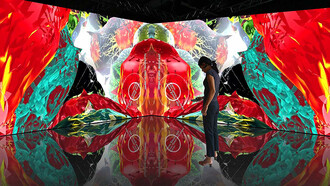In 1888, George Eastman launched the first film camera on the market with the charismatic slogan: "You push the button, we do the rest." Surely, he was far from imagining that a little more than half a century later, another device—the cell phone— would take the consumption and practice of photography to previously unthinkable levels. Because of its intuitive function, the Kodak 100 Vista made portraits accessible to the general amateur public. The android, its successor in the digital age, imposed new stereotypes in photography, awakening a narcissistic fascination for self-representation.
Only a few years have passed between the classic “zapping” of television consumption to the inexhaustible “scroll-down” of Internet pages, but it’s been long enough to infinitely multiply the faces of contemporary humans on the virtual highways of the global village. The era of Photoshop and selfies has illusory filters and a whole cosmetology of charisma in portraits. This charisma could very well lead to a complete reformulation of the historical values of that set of notions that we usually refer to as “the photogenic.”
In the context of these significant media transitions, validity is finally given to certain photographic inquiries that, somewhat alternatively, rescue a historical aura in a kind of return to the foundational images of 19th-century portraits. This spirit of citation, of appropriation of historical visuality and of retrospective explorations carried out from the effective technologies of the present, is indispensable to understanding the exhibition J. Tomás López: The Portrait Series. This fascinating collection of portraits was exhibited at the Lowe Museum at Miami University, and was curated by Jill Deupi, the institution's director.
López's portraits challenge the viewer from that singularity that defines each subject as a universe in themselves, but also from the sustained development of the theme-turned-series. There is a game of scrutiny and curiosities in the contemplation of each work that captures the viewer's sensitivity, inviting them to unveil the next one. Seen as a whole, the photographs make up a specific archive: the iconic record of a group of people related to the author whose portraits now find themselves in “nobody's zone.” This space belongs neither to the photographer nor to the subject—not even to the viewer— but rather to the photograph itself.
The iconic Richard Avedon perceived this complex relationship of roles when he reviewed the portraits he had dedicated to his father years before: “The way someone being portrayed presents themselves to the camera and the effect of the photographer's response in relation to that presence is what a portrait is about (…). Whatever happened at the time was important to us but not to the photographs. What was captured is autonomous and, in some strange way, it is free from both of us.”
Armed with a lens that reproduces the imperfections and astigmatism of 19th-century lenses, J. Tomás López disposes of superfluous details by concentrating the realism of the focus on the gaze of the posing subject. The scarce focal depth of the lens is responsible for erasing every detail outside the contained space that could dissociate the hypnotic power of the gaze. Backgrounds melt away as hair and clothing dissolve into insinuations of forms that progressively disappear into emptiness. The ocher tones of the prints resemble the sepia tones of nineteenth-century photography. Despite belonging to the digital age, Tomás López’ introspective portraits share the spirit and aura of historical plates like those that came from the studies of Julia Margaret Cameron or the charismatic Félix Nadar.
According to semiologist Roland Barthes, the portrait can only be understood through the Mask, a system of signals historically encoded to decipher the image of people from their physiognomy and culture. But in The Portrait Series, this system is kept to a minimum. There are no backgrounds or scenes that allow for subjects to be linked to their context, nor titles that certify their professions or origins, as in the sociological portraits of August Sander. The works are simply labeled with the name of the person portrayed. The Mask in these images is an open door and an invitation to reveal, from the recognition of diversity, the range of attitudes and emotions that make up human nature. This is done, not as a simple gesture of aesthetic appropriation of the work and its meanings, but as an exercise in self-recognition that summarizes the magic and complicity between the viewer and the image of their fellow humans.
Perhaps this is where portraits’ undeniable power to evoke emotion comes from: the possibility of self-recognition in the mirror of others. Through an introspective journey into personal experiences, we discover that which sums us up, which brings us closer to ourselves, and which makes us equal to our neighbors. As Octavio Paz said: “In order to be, I have to be someone else; get out of myself, look for myself in others. The others who cannot be if I am not. The others who give me full existence.”















